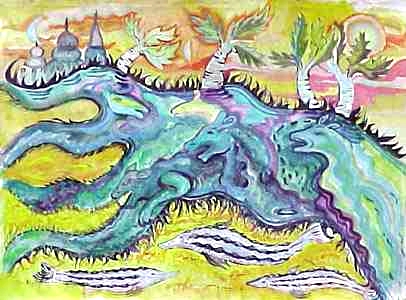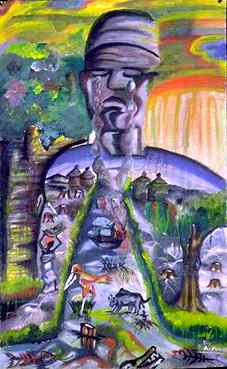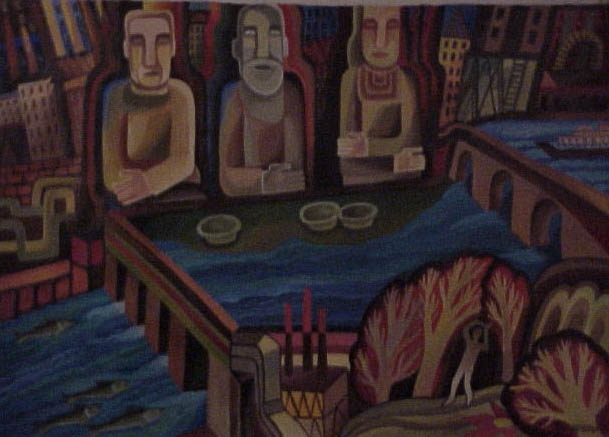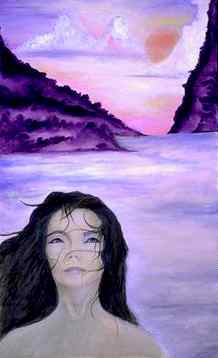
Bernice Davidson
Summertown, Tennessee USA
In addition to her own paintings, Bernice has collected work by artists from many nations which call attention to the plights of the world’s waterways, showing these at exhibitions all over the world.
PULASKI, TENN. JULY 30, 2009
A contingent of students and professional artists from Tennessee will leave for Cordova, Alaska, on Thursday, July 30, where they will learn about the Copper River Watershed Project and create art pieces for inclusion in the international project’s traveling exhibit.
The Global Rivers Art Exchange is the brainchild of Bernice Davidson, assistant professor of art at Martin Methodist College in Pulaski, Tenn. Davidson, an accomplished artist, started the project a decade ago in Ohio as a response to a threatened waterway, the Cuyahoga River. Her students in Cleveland began putting their thoughts and emotions into their artwork, and, after securing a funding grant, she took their paintings to Ghana, West Africa. It was the students’ desire, she said, to warn young people in another part of the world to be good stewards of their rivers and waterways. Over the past several years, the art exchange also included a trip to Volgograd, Russia, and now the project moves to Alaska.
“I feel honored to have an opportunity to learn from one of the most well developed water projects I’ve ever seen,” Davidson said. “The Copper River Watershed Project differs from the other sites we have visited because it is proactive in its protection efforts.”
With the help of Kristin Smith, executive director of the Copper River Watershed Project, and local artists Barbara Harville, David Rosenthal and Paula Payne, five Martin Methodist students Caleab Farley of Toney, Ala.; Michaela Jacobs of Leoma, Tenn.; Jessie Bain and Todd Camp of Hendersonville, Tenn.; and Ashley Baez of Pulaski will be joined by Davidson, assistant Jessie Lerner, and renowned Mexican artist Gerta Hansburg in spending six days studying the water issues surrounding Cordova and creating artwork to share across the globe.
“We want to create a venue for artists work to be included in a September showing of the Global Rivers Art at the Valdez Museum,” Davidson said. “Any artist is welcome to work on the project during our stay.”
During the group’s stay, Davidson will give a presentation at the Valdez Museum.
Davidson said she and the students have studied the works created by the Artists for Nature group that created a book of art in 1996 that depicted the many scenic aspects of the watershed.
“Their work is weepingly beautiful. We are hoping to be able to visit some of the breathtaking sites they chose for their paintings,” she said.
Also during the Tennessee group’s stay will be a mini-exhibit of artwork at the Catholic Church. Davidson said she hopes the Cordova community will visit the exhibit and exchange knowledge about the protection of endangered waterways around the world.
Volta River, Ghana, West Africa

From the Artist: “The future looks dark, not dark by night but by pollution of our rivers and our lakes. I could imagine how sad the up and coming generation will be. All the trees are cut down, rivers polluted by animal waste and machine and boat smoke. Let all unite and fight against the pollution.”
Editors Note: We were so surprised to see the Danzu river when we left the airport in Accra. It seemed it had been used as a garbage dump. Trash was piled high on its green banks and the river itself was gray and murky.
Volga River, Volgograd, Russia

Editors Note: This painting addressees the ecological impact that the dam at Volshki has had on the Volga River. Because of the temperature increase in the Volga River (5 degrees since the dam’s creation), the population of the sturgeon is almost extinct. Their spawning was greatly curtailed because of this increase. The three figures are shown with empty plates to symbolize that the sturgeon is all but gone. The fire in the front of the painting depicts a forest fire that took place the summer of our visit which took out many acres of hardwood trees.

Bernice Davidson
Summertown, Tennessee USA
The bio region of the Volga river in Volgograd is a fertile area known as an alluvial fan. The river breaks up into many tributaries and the soil is so rich and black it is known as the “Kitchen Garden” of Russia. My painting shows this fan formation of the river. The images found in the river are inspired by designs made by an ancient tribe of warriors known as Sematrians who lived in this area around 2,000 B.C. They were a matriarchal society of fierce warriors. We learned that the women of this tribe had to have performed successfully in battle before they were permitted to marry.
Harpeth River, Brentwood, Tennessee

Luke Beata, age 18
Harpeth River, Tennessee
This work portrays the beauty of the river through idealistic eyes. Signs of man’s negative impact upon the Harpeth have been ignored. The fantasy-like hills, swirling sunset, and seemingly boundless waters symbolize the untamed purity of nature and suggest that a similar quality lies between the true heart of humanity. The woman depicted parallels the wild beauty around her, ultimately implying the importance of protecting and maintaining the environment which is so much a part of us.
